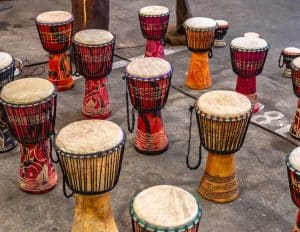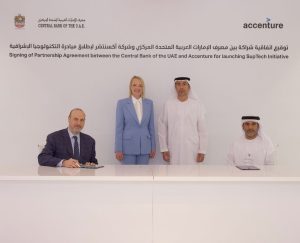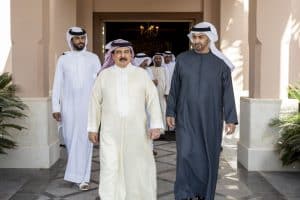
Statistics Centre – Abu Dhabi (SCAD) has issued its quarterly report on non-oil merchandise trade through the ports of the Emirate of Abu for Q2 2014 to support decision makers and businesses with accurate and up-to-date statistics on the non-oil merchandise that entered or exited the territory of the Emirate of Abu Dhabi through the emirate’s ports (including air, sea and land ports) during the reference period.
The report highlights the relative importance of each individual component of imports, non-oil exports and re-exports. It is worth noting that the report data does not exhaustively cover Abu Dhabi’s foreign trade since a considerable proportion of it flows through the ports of other emirates.
— Imports by Standard International Trade Classification (SITC4) ‘Machinery and transport equipment’ was the largest contributor to imports by SITC4 in Q2 2014, representing 48.4 percent of the total. Its value increased by AED 2.7 billion (25.1 percent) in Q2 2014 compared with Q2 2013. The main contributors to this increase were the sub-sections “Machinery specialsed for particular industries” (up AED 1.0 billion) and “Road vehicles (up AED 993 million).
The second largest SITC4 section in Q2 2014 was “Manufactured goods classified by material”, representing 21.7 percent of the total. Its value decreased by AED 1.1 billion (-15.4 percent) compared with Q2 2013. The largest sub-sections in Q2 2014 were “Iron and steel” (down AED 767 million) and “Non-ferrous metals” (down AED 377 million).
The third largest SITC4 section was “Chemicals and related products” representing 10.5 percent of the total. Its value increased by AED 580 million (25.1 percent) over the period, mainly due to increases in “Plastics in primary forms” (up AED 157 million) and “Inorganic chemicals” (up AED 151 million).
These top three sections contributed 80.6 percent of the total value of imports in Q2 2014, compared with 78.2 percent in Q2 2013.
— Imports by Broad Economic Categories (BEC) As SCAD’s report finds, “Industrial supplies not elsewhere specified” was the largest BEC category of imports in Q2 2014 representing 37.0percent of the total value. Its value decreased by AED 1.5 billion (-12.7percent) in Q2 2014 compared with Q2 2013.
The second largest BEC category, “Transport equipment and parts”, increased by AED 792 million (12.8 percent) compared with the Q2 2013 value, while the third largest BEC category, “Capital goods (except transport equipment)”, showed an increase of AED 2.1 billion (45.0 percent over the same period.
— Imports by Harmonised System (HS Chapter) The 7.5 percent rise in the value of imports over the period was mainly due to an increase of AED 1.7 billion (45.0percent) in “Boilers, machinery, mechanical appliances and parts” and AED 1.0 billion (29.3 percent) in “Vehicles other than railway; parts”. These were partially offset by decreases of AED 664 million (-29.8 percent) in “Articles of iron and steel” and AED 523 million (-20.5percent) in “Copper and articles thereof”.
— Imports by continent With a share of 47.2 percent, Asia represented the leading source of imports through the ports of Abu Dhabi during Q2 2014. Imports from Europe and North America represented 29.7 percent and 12.0 percent of total imports in Q2 2014, respectively.
— Imports by continent Source: Abu Dhabi Department of Finance – Customs Administration — Imports by country A comparison by country shows that the top ten imports trading partners contributed 67.5 percent of total imports in Q2 2014. The United States of America was the leading source, supplying goods worth AED 3.2 billion, an increase of AED 88 million (2.9 percent) compared with Q2 2013. There were increases in imports from South Korea (up AED 951 million), Germany (up AED 469 million) and China (up AED 356 million); partially offset by decreases from Oman (down AED 276 million) and Italy (down AED 73 million) over the period.
— Non-oil exports by Standard International Trade Classification (SITC4) The report reveals an increase of AED 465 million (11.5percent) in the value of non-oil exports during the second quarter of 2014 compared with the same period in previous year.
The largest SITC4 section was “Manufactured goods classified by material”, which increased by AED 245 million (10.8 percent) compared with Q2 2013. This increase was due to the sub-section “Non-ferrous metals” (up AED 284 million), partially offset by a decrease in “Iron and steel” (down AED 83 million).
The second largest SITC4 category, “Chemicals and related products”, showed an increase of AED 211 million (17.3 percent) over the period. The main contributor was the sub-section “Plastics in primary forms” which increased by AED 181 million (15.9 percent).
The third largest SITC4 section was “Machinery and transport equipment”, decreased by AED 3 million (-1.0 percent) during the period. These top three sections contributed 93.9 percent of the total value of non-oil exports in Q2 2014 compared with 93.5 percent in Q2 2013.
Non-oil exports by Broad Economic Categories (BEC) The largest BEC category of non-oil exports in Q2 2014 was “Industrial supplies not elsewhere specified” with a value of AED 3.9 billion (85.9 percent of total). This category showed an increase of AED 416 million (12.0 percent) compared with Q2 2013.
The second largest BEC category, “Capital goods (except transport equipment)”, increased by AED 47 million (21.0 percent), while the third largest BEC category, “Food and beverages”, showed an increase of AED 20 million (14.0 percent) over the period. The top three categories contributed 95.6 percent of the total value of non-oil exports in Q2 2014, compared with 94.6 percent in Q2 2013.
Non-oil Exports by the Harmonised System (HS) Chapters The rise in non-oil exports during the period was mainly due to an increase of AED 505 million (2,148.0 percent) in “Aluminium and articles thereof” and AED 187 million (15.8 percent) in “Plastics and articles thereof”, partially offset by a decrease of AED 165 million (-14.3 percent) in “Copper and articles thereof”.
— Non-oil exports by continent Asia was the leading destination (85.7 percent) for Abu Dhabi non-oil exports during Q2 2014. The next largest continents were Africa and Europe, contributing 6.3 percent and 5.8 percent of the total value of non-oil exports in Q2 2014, respectively.
— Non-oil exports by continent Source: Abu Dhabi Department of Finance – Customs Administration — Non-oil exports by country SCAD’s report shows that the top ten export partners contributed 76.6 percent of total non-oil exports in Q2 2014. Saudi Arabia was the leading destination with AED 1.5 billion, a decrease of AED 327 million (-17.9 percent) compared with Q2 2013. There were increases in non-oil exports to India (up 122 million), Japan (up 95 million) and Qatar (up AED 87 million) over the period.
Re-exports by Standard International Trade Classification (SITC4) “Machinery and transport equipment” was the largest contributor to the total value of re-exports during Q2 2014 representing 68.0 percent of the total value, a decrease of AED 20 million (-0.7 percent) compared with Q2 2013. There was a decrease of AED 251 million (-33.2 percent) in the sub-section “Office machines and automatic data processing machines”, partially offset by increases of AED 129 million (27.7 percent) in “Road vehicles (incl. air-cushion vehicles)” and AED 95 million (37.6 percent) in “General industrial machinery and equipment, nes, and machine parts.” The second largest section “Miscellaneous manufacturing articles” decreased by AED 247 million (-25.0 percent) over the period, and represented 17.4 percent of total re-exports in Q2 2014. The main contributor was the sub-section “Articles of apparel and clothing accessories”, which decreased by AED 164 million (-28.1 percent) over the period.
“Manufactured goods classified by material” was the third largest SITC4 section, and it increased by AED 12 million (4.9 percent) over the period.
The top three sections contributed 91.2 percent of total re-exports in Q2 2014, compared with 92.3 percent in Q2 2013.
— Re-exports by Broad Economic Categories (BEC) According to the report, “Capital goods (except transport equipment)” was the largest BEC category of re-exports in Q2 2014 representing 38.6 percent of the total value, a decrease of AED 280 million (-14.5 percent) compared with Q2 2013. The second largest category was “Transport equipment and parts” which contributed 28.1 percent of re-exports in Q2 2014, an increase in value of AED 204 million (20.5 percent) compared with Q2 2013. The third largest category “Consumer goods not elsewhere specified” decreased by 140 AED million (-11.1 percent) over the period The top three categories contributed 93.0 percent of total re-exports in Q2 2014, compared with 93.2 percent in Q2 2013.
— Re-exports by Harmonised System (HS Chapter) The 4.9 percent decline in the value of re-exports over the period was mainly due to a decrease of AED 245 million (-14.3 percent) in “Boilers, machinery, mechanical appliances and parts” and AED 121 million (-26.5 percent) in “Knitted or crocheted articles of apparel”.
— Re-exports by continent Asia was the top destination for Abu Dhabi’s re-exports in Q2 2014, importing 83.5 percent of the total re-exports. The next largest continent was Europe, contributing 12.4 percent to the total value of re-exports in Q2 2014.
Source: Abu Dhabi Department of Finance – Customs Administration — Re-exports by country The top ten re-export partners contributed 85.2 percent of total re-exports in Q2 2014. The leading re-exports destination were Saudi Arabia (18.5 percent of the total) followed by the Kingdom of Bahrain (16.9 percent), Qatar (16.9 percent) and Kuwait (13.9 percent).
SCAD pointed out that not all of the goods covered in the report belong to the Emirate of Abu Dhabi Abu Dhabi, nor do the figures presented in it represent the emirate’s trade with the outside world, since a proportion of these goods belong to other emirates. In addition, the report does not monitor the flows of inbound/outbound merchandise through the ports of the other Emirates.
He also pointed out that the Centre Department of Finance – Customs Administration is the source of the data used in the compilation of the report, which cover only trade flows recorded at the customs ports that fall under the jurisdiction of the Customs Administration.
Source : WAM News Agency for United Arab Emirates












